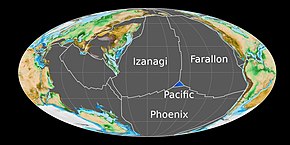Pacific Plate
| Pacific Plate | |
|---|---|
 | |
| Type | Major |
| Approximate area | 103,300,000 km2 (39,900,000 sq mi)[1] |
| Movement1 | north-west |
| Speed1 | 56–102 mm (2.2–4.0 in)/year |
| Features | Baja California Peninsula, Southern California, Hawaiian Islands, New Zealand, Solomon Islands archipelago, Southeast Alaska, Pacific Ocean |
| 1Relative to the African Plate | |

The Pacific Plate is an oceanic tectonic plate that lies beneath the Pacific Ocean. At 103 million km2 (40 million sq mi), it is the largest tectonic plate.[2]
The Pacific Plate contains an interior hot spot forming the Hawaiian Islands.[3]
Hillis and Müller are reported to consider the Bird's Head Plate to be moving in unison with the Pacific Plate.[4] Bird considers them to be unconnected.[5]
Boundaries[]
The north-eastern side is a divergent boundary with the Explorer Plate, the Juan de Fuca Plate and the Gorda Plate forming respectively the Explorer Ridge, the Juan de Fuca Ridge and the Gorda Ridge. In the middle of the eastern side is a transform boundary with the North American Plate along the San Andreas Fault, and a boundary with the Cocos Plate. The south-eastern side is a divergent boundary with the Nazca Plate forming the East Pacific Rise.[citation needed]
The southern side is a divergent boundary with the Antarctic Plate forming the Pacific–Antarctic Ridge.[citation needed]
The western side is bounded by the Okhotsk Plate at the Kuril–Kamchatka Trench and the Japan Trench. The plate forms a convergent boundary by subducting under the Philippine Sea Plate creating the Mariana Trench, has a transform boundary with the Caroline Plate, and has a collision boundary with the North Bismarck Plate.[citation needed]
In the south-west, the Pacific Plate has a complex but generally convergent boundary with the Indo-Australian Plate, subducting under it north of New Zealand forming the Tonga Trench and the Kermadec Trench. The Alpine Fault marks a transform boundary between the two plates, and further south the Indo-Australian Plate subducts under the Pacific Plate forming the Puysegur Trench. The southern part of Zealandia, which is to the east of this boundary, is the plate's largest block of continental crust.[citation needed]
The northern side is a convergent boundary subducting under the North American Plate forming the Aleutian Trench and the corresponding Aleutian Islands.
Paleo-geology of the Pacific Plate[]

The Pacific Plate is almost entirely oceanic crust, but it contains some continental crust in New Zealand, Baja California, and coastal California.[3]
The Pacific Plate has the distinction of showing one of the largest areal sections of the oldest members of seabed geology being entrenched into eastern Asian oceanic trenches. A geologic map of the Pacific Ocean seabed shows not only the geologic sequences, and associated Ring of Fire zones on the ocean's perimeters, but the various ages of the seafloor in a stairstep fashion, youngest to oldest, the oldest being consumed into the Asian oceanic trenches. The oldest part disappearing by way of the plate tectonics cycle is early-Cretaceous (145 to 137 million years ago).[6]
The Pacific Plate originated at the triple junction of the three main oceanic plates of Panthalassa, the Farallon, Phoenix, and Izanagi Plates, around 190 million years ago. The plate formed because the triple junction had converted to an unstable form surrounded on all sides by transform faults, due to the development of a kink in one of the plate boundaries. The "Pacific Triangle", the oldest part of the Pacific Plate, created during the initial stages of plate formation, is located just east of the Mariana Trench.[7]
References[]
- ^ "Here are the Sizes of Tectonic or Lithospheric Plates". Archived from the original on 2016-06-05. Retrieved 2015-05-04.
- ^ "SFT and the Earth's Tectonic Plates". Los Alamos National Laboratory. Archived from the original on 17 February 2013. Retrieved 27 February 2013.
- ^ Jump up to: a b Wolfgang Frisch; Martin Meschede; Ronald C. Blakey (2 November 2010). Plate Tectonics: Continental Drift and Mountain Building. Springer Science & Business Media. pp. 11–12. ISBN 978-3-540-76504-2.
- ^ Hillis, R. R.; Müller, R. D. (2003). Evolution and Dynamics of the Australian Plate. Boulder, Colorado: Geological Society of America. p. 363. ISBN 0-8137-2372-8.
- ^ Bird, Peter (2003). "An updated digital model of plate boundaries". Geochemistry, Geophysics, Geosystems. 4 (3): 1027. Bibcode:2003GGG.....4.1027B. doi:10.1029/2001GC000252.
- ^ "Age of the Ocean Floor". Archived from the original on 2016-08-06. Retrieved 2009-02-07.
- ^ Boschman, Lydian M.; Hinsbergen, Douwe J. J. van (2016-07-01). "On the enigmatic birth of the Pacific Plate within the Panthalassa Ocean". Science Advances. 2 (7): e1600022. doi:10.1126/sciadv.1600022. ISSN 2375-2548.
External links[]
| Wikimedia Commons has media related to Pacific tectonic plate. |
- Tectonic plates
- Geology of the Pacific Ocean
- Natural history of North America
- Natural history of Hawaii
- Natural history of Oceania
- Natural history of Japan
- Geology of the Russian Far East
- Geology of California
- Geology of New Zealand
